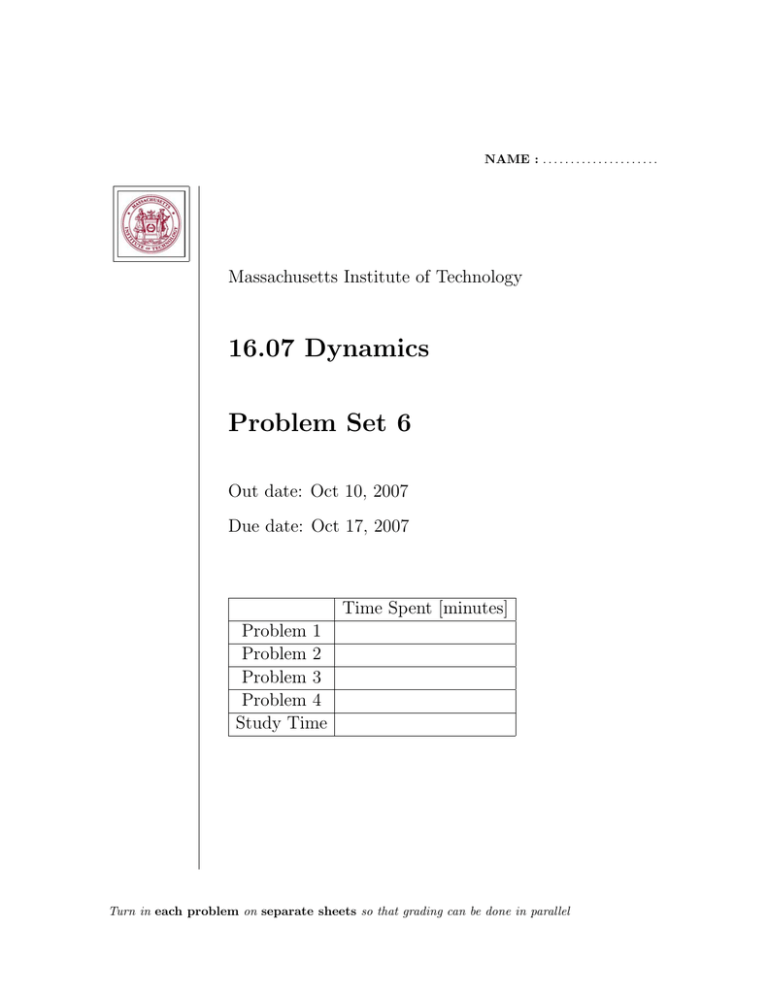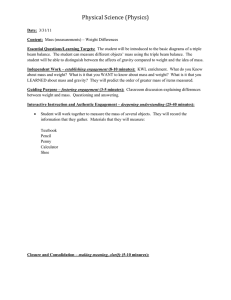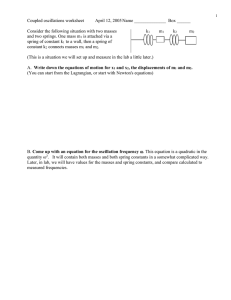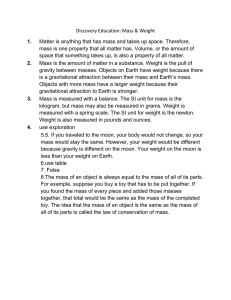Document 13352609
advertisement

NAME : . . . . . . . . . . . . . . . . . . . . . Massachusetts Institute of Technology 16.07 Dynamics Problem Set 6 Out date: Oct 10, 2007 Due date: Oct 17, 2007 Time Spent [minutes] Problem 1 Problem 2 Problem 3 Problem 4 Study Time Turn in each problem on separate sheets so that grading can be done in parallel Problem 1 (10 points) The geometry of a ”half-pipe” as used in skateboard competition is a flat horizontal surface separating two circular arcs of radius R0 . Pumping is the process by which the skateboarder does work and gains kinetic energy to make the next spectacular move. (This really works!!!! But maybe I’ve been watching too much TV.) Consider a skateboarder of mass m in the half-pipe. Assume he starts from height h0 with zero velocity. He is standing up so that his center of mass is R1 from the center of curvature of the circular section of the pipe. As he goes through the flat section, the height of his center of mass above the track is h = R0 − R1 . (Represent the skateboarder as a point mass located at his center of mass. Assume for your convenience that R2 − R1 << R0 .) A-1 1. In case a, he traverses the pipe without change of stance. Ignoring wind resistance and friction, what height will be reach on the other side of the pipe? A-2 What normal force is felt on his feet as a function of position in the half pipe? In the round section? In the flat section? Now consider case b). He starts with the same initial conditions. However, in this case, when he reaches the flat section, he crouches so that his center of mass is now at h = R0 − R2 above the flat section of the track. B-1 Does he do work? Positive or negative? What is his velocity? What is his potential energy. Now as he enters the curved portion of the track, he stands up so that his center of gravity is now at R1 where R1 < R2 . B-1 Does he do work? Positive or negative? How much? What is his resulting potential energy? What is his resulting kinetic energy? Where should he stand up from his crouch to maximize the work done? B-2 What height will now be reached on the other side? B-3 Where should he regain his crouch so that the process can be repeated on the next cycle resulting in maximum energy gain? Problem 2 (10 points) Consider 3 different impact problems. In all the configurations, a mass m traveling at velocity V0 impacts another mass m which is at rest. a) In the first example, the mass is suspended by a string from a fixed support in the presence of gravity. What is the tension in the string immediately after the collision? b) In the second example, the mass is suspended by a massless rigid rod which is fee to rotate about an axel fixed to the support in the presence of gravity. What is the force in the rod immediately after the collision? c) In the final example, the mass system consists of a dumbbell, two equal masses connected by a massless rod resting on a frictionless plane. What is the force is the rod immediately after the collision? Problem 3 (10 points) Part A Two masses m1 = m and m2 =3m resting on a frictionless plane are joined together by a spring of length L0 which has been compressed from its equilibrium length of Leq . The spring has a spring constant k. The configuration is held together by a string which keeps the spring compressed. At t = 0, the string is cut. • How much elastic energy is stored in the system before t=0? • What happens when the string is cut? • Is there a necessary relationship between the motion of m1 and m2 ? • What is the maximum kinetic energy of the system? • For what relative position (distance) between the masses does this occur? • The resulting motion will be a sinusoidal oscillation. What will the frequency be? Part B. B-1. Consider a rocket blasting off in a gravitational field at a trajectory angle θ. What combination of ṁ and c is required to get off the ground? What happens if ṁ and c are less than this value? B-2. Show that in the absence of gravity, the net momentum change imparted to a system by the thrust of a rocket is independent of the burn time and given only by c and the mass change. Problem 4 (Hint: do problem 3 first!) (10 points) Note: ignore gravity throughout this problem. Part A. The final displacement h of the tip of a cantilevered beam of stiffness EI caused by the application of a point load P is P L3 h= (1) 3EI What elastic energy is stored in the beam as a result of this process? (This process is similar to the process that stores energy in a spring.) Part B-1. Now consider that this beam has attached to its end a mass m. Take the beam as massless. What is the energy when the beam is displaced and restrained at distance h0 ? Ignore gravity. What happens when the beam is released? What is the maximum kinetic energy of the system? Part B-2. An oscillation ensues. What is the frequency of oscillation? Now consider the system sketched in c), a central mass of 2 m holding two cantilevered beams each of length L; tip masses of m are placed at either end to form a symmetric configuration. The system is in free space without any external support. This could be a good model for the vibration of an aircraft fuselage, with a tip mounted engine on each wing, although in your analysis you should ignore any aerodynamic forces. Consider only the symmetric motion, where both tip masses move in the same direction. Assume both wing tips are somehow held at a deflection h0 , and then released. C-1 What is the constraint on the motion of the 3 masses with respect to one another? C-2 For this constraint, what is the relationship between the velocity of the 3 masses, v1 , v2 , and v3 . (Given that the motion is symmetric, v1 = v3 .) C-2 What is the frequency of vibration of the system? Part D For wild and crazy extra credit, what is the natural frequency of the asymmetric motion, that in which the 2 tip masses move in opposite directions? What does the center mass do in the asymmetric motion? MIT OpenCourseWare http://ocw.mit.edu 16.07 Dynamics Fall 2009 For information about citing these materials or our Terms of Use, visit: http://ocw.mit.edu/terms.






